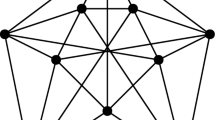Abstract
A graph G is called \((H_1, H_2)\)-free if G contains no induced subgraph isomorphic to \(H_1\) or \(H_2\). Let \(P_k\) be a path with k vertices and \(C_{s,t,k}\) (\(s\le t\)) be a graph consisting of two intersecting complete graphs \(K_{s+k}\) and \(K_{t+k}\) with exactly k common vertices. In this paper, using an iterative method, we prove that the class of \((P_5,C_{s,t,k})\)-free graphs with clique number \(\omega \) has a polynomial \(\chi \)-binding function \(f(\omega )=c(s,t,k)\omega ^{\max \{s,k\}}\). In particular, we give two improved chromatic bounds: every \((P_5, butterfly)\)-free graph G has \(\chi (G)\le \frac{3}{2}\omega (G)(\omega (G)-1)\); every \((P_5, C_{1,3})\)-free graph G has \(\chi (G)\le 9\omega (G)\).

Similar content being viewed by others
Data availibility
The manuscript has no associated data.
References
Bacsó G, Tuza Z (1990) Dominating cliques in \(P_5\)-free graphs. Period Math Hung 21(4):303–308
Brause C, Doan T, Schiermeyer I (2016) On the chromatic number of \((P_5, K_{2, t})\)-free graphs. Electron Notes Discrete Math 55:127–130
Brause C, Randerath B, Schiermeyer I, Vumar E (2019) On the chromatic number of \(2K_2\)-free graphs. Discrete Appl Math 253:14–24
Chudnovsky M, Sivaraman V (2019) Perfect divisibility and 2-divisibility. J Graph Theory 90(1):54–60
Chudnovsky M, Robertson N, Seymour P, Thomas R (2006) The strong perfect graph theorem. Ann Math 164:51–229
Chudnovsky M, Karthick T, Maceli P, Maffray F (2020) Coloring graphs with no induced five-vertex path or gem. J Graph Theory 95(4):527–542
Erdős P (1959) Graph theory and probability. Class Pap Comb 11:34–38
Esperet L, Lemoine L, Maffray F, Morel G (2013) The chromatic number of \((P_5, K_4)\)-free graphs. Discrete Math 313:743–754
Fouquet J, Giakoumakis V, Maire F, Thuillier H (1995) On graphs without \(P_5\) and \(\bar{P_5}\). Discrete Math 146:33–44
Gravier S, Hoàng CT, Maffray F (2003) Coloring the hypergraph of maximal cliques of a graph with no long path. Discrete Math 272(2–3):285–290
Gyárfás A (1987) Problems from the world surrounding perfect graphs. In: Proceedings of international conference on combinatorial analysis and applications, vol 19, pp 413–441
Huang S, Karthick T (2021) On graphs with no induced five-vertex path or paraglider. J Graph Theory 97(2):305–323
Karthick T, Maffray F (2016) Vizing bound for the chromatic number on some graph classes. Graphs Comb 32:1447–1460
Karthick T, Mishra S (2018) Chromatic bounds for some classes of \(2K_2\)-free graphs. Discrete Math 341(11):3079–3088
Randerath B (1998) The Vizing bound for the chromatic number based on forbidden pairs. Ph.D. thesis, RWTH Aachen, Shaker Verlag
Schiermeyer I (2016) Chromatic number of \(P_5\)-free graphs: Reed’s conjecture. Discrete Math 339(7):1940–1943
Schiermeyer I (2017) On the chromatic number of \((P_5, windmill)\)-free graphs. Opusc Math 37(4):609–615
Schiermeyer I, Randerath B (2019) Polynomial \(\chi \)-binding functions and forbidden induced subgraphs: a survey. Graphs Comb 35:1–31
Scott A, Seymour P, Spirkl S (2023) Polynomial bounds for chromatic number. IV: A near-polynomial bound for excluding the five-vertex path. Combinatorica 43:845–852
Sumner D (1981) Subtrees of a graph and chromatic number. In: Chartrand G (ed) The theory and applications of graphs. Wiley, New York, pp 557–576
Wagon S (1980) A bound on the chromatic number of graphs without certain induced subgraphs. J Comb Theory Ser B 29(3):345–346
Acknowledgements
The authors would like to thank the referees for careful reading and valuable comments.
Author information
Authors and Affiliations
Corresponding author
Ethics declarations
Conflict of interest
The authors have no relevant financial or non-financial interests to disclose.
Additional information
Publisher's Note
Springer Nature remains neutral with regard to jurisdictional claims in published maps and institutional affiliations.
This research was supported by the National Natural Science Foundation of China (No. 12071265), the Shandong Provincial Natural Science Foundation (No. ZR2019MA032).
Rights and permissions
Springer Nature or its licensor (e.g. a society or other partner) holds exclusive rights to this article under a publishing agreement with the author(s) or other rightsholder(s); author self-archiving of the accepted manuscript version of this article is solely governed by the terms of such publishing agreement and applicable law.
About this article
Cite this article
Xu, W., Zhang, X. On the chromatic number of \(P_5\)-free graphs with no large intersecting cliques. J Comb Optim 46, 22 (2023). https://doi.org/10.1007/s10878-023-01088-5
Accepted:
Published:
DOI: https://doi.org/10.1007/s10878-023-01088-5




